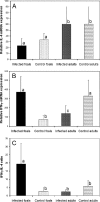Experimental infection of neonatal foals with Rhodococcus equi triggers adult-like gamma interferon induction
- PMID: 17409222
- PMCID: PMC1951072
- DOI: 10.1128/CVI.00042-07
Experimental infection of neonatal foals with Rhodococcus equi triggers adult-like gamma interferon induction
Abstract
Rhodococcus equi is a facultative intracellular pathogen that causes pneumonia in young foals but does not induce disease in immunocompetent adult horses. Clearance of R. equi depends mainly on gamma interferon (IFN-gamma) production by T lymphocytes, whereas the predominance of interleukin 4 (IL-4) is detrimental. Young foals, like neonates of many other species, are generally deficient in the ability to produce IFN-gamma. The objective of this study was to compare the cytokine profiles, as well as cell-mediated and antibody responses, of young foals to those of adult horses following intrabronchial challenge with R. equi. The lymphoproliferative responses of bronchial lymph node (BLN) cells to concanavalin A were significantly higher in foals than in adult horses. In contrast, adult horses had significantly higher lymphoproliferative responses to R. equi antigens than did foals. Infected foals had significantly lower IL-4 mRNA expression but significantly higher IFN-gamma expression and IFN-gamma/IL-4 ratio in R. equi-stimulated BLN lymphocytes than did infected adults. Infection with R. equi in foals resulted in a significant increase in the percentage of T lymphocytes and CD4(+) T lymphocytes in bronchoalveolar lavage fluid in association with a significant decrease in the percentage of these cell populations in BLNs. Infection of foals also resulted in a marked increase in serum immunoglobulin Ga (IgGa) and IgGb levels, resulting in concentrations in serum that were significantly higher than those of adult horses. This study demonstrates that the immune response to R. equi in foals is not biased toward IL-4 and is characterized by the predominant induction of IFN-gamma.
Figures




Similar articles
-
In vivo expression of and cell-mediated immune responses to the plasmid-encoded virulence-associated proteins of Rhodococcus equi in foals.Clin Vaccine Immunol. 2007 Apr;14(4):369-74. doi: 10.1128/CVI.00448-06. Epub 2007 Feb 14. Clin Vaccine Immunol. 2007. PMID: 17301216 Free PMC article.
-
Effects of inoculum size on cell-mediated and humoral immune responses of foals experimentally infected with Rhodococcus equi: a pilot study.Vet Immunol Immunopathol. 2010 Feb 15;133(2-4):282-6. doi: 10.1016/j.vetimm.2009.08.004. Epub 2009 Aug 13. Vet Immunol Immunopathol. 2010. PMID: 19720402
-
Effects of two commercially available immunostimulants on leukocyte function of foals following ex vivo exposure to Rhodococcus equi.Vet Immunol Immunopathol. 2010 Dec 1;138(3):198-205. doi: 10.1016/j.vetimm.2010.07.027. Epub 2010 Aug 6. Vet Immunol Immunopathol. 2010. PMID: 20822815
-
Rhodococcus equi: clinical manifestations, virulence, and immunity.J Vet Intern Med. 2011 Nov-Dec;25(6):1221-30. doi: 10.1111/j.1939-1676.2011.00804.x. Epub 2011 Oct 7. J Vet Intern Med. 2011. PMID: 22092609 Review.
-
Current understanding of the equine immune response to Rhodococcus equi. An immunological review of R. equi pneumonia.Vet Immunol Immunopathol. 2010 May 15;135(1-2):1-11. doi: 10.1016/j.vetimm.2009.12.004. Epub 2009 Dec 23. Vet Immunol Immunopathol. 2010. PMID: 20064668 Review.
Cited by
-
Equine neonates have attenuated humoral and cell-mediated immune responses to a killed adjuvanted vaccine compared to adult horses.Clin Vaccine Immunol. 2010 Dec;17(12):1896-902. doi: 10.1128/CVI.00328-10. Epub 2010 Oct 13. Clin Vaccine Immunol. 2010. PMID: 20943883 Free PMC article.
-
Foal monocyte-derived dendritic cells become activated upon Rhodococcus equi infection.Clin Vaccine Immunol. 2009 Feb;16(2):176-83. doi: 10.1128/CVI.00336-08. Epub 2008 Dec 24. Clin Vaccine Immunol. 2009. PMID: 19109450 Free PMC article.
-
Regulatory T cells in early life: comparative study of CD4+CD25high T cells from foals and adult horses.PLoS One. 2015 Mar 19;10(3):e0120661. doi: 10.1371/journal.pone.0120661. eCollection 2015. PLoS One. 2015. PMID: 25790481 Free PMC article.
-
Microbial Degradation of Plastic in Aqueous Solutions Demonstrated by CO2 Evolution and Quantification.Int J Mol Sci. 2020 Feb 11;21(4):1176. doi: 10.3390/ijms21041176. Int J Mol Sci. 2020. PMID: 32053975 Free PMC article.
-
IgG Subtype Response against Virulence-Associated Protein A in Foals Naturally Infected with Rhodococcus equi.Vet Sci. 2024 Sep 9;11(9):422. doi: 10.3390/vetsci11090422. Vet Sci. 2024. PMID: 39330801 Free PMC article.
References
-
- Adkins, B. 2000. Development of neonatal Th1/Th2 function. Int. Rev. Immunol. 19:157-171. - PubMed
-
- Adkins, B. 2005. Neonatal T cell function. J. Pediatr. Gastroenterol. Nutr. 40(Suppl. 1):S5-S7. - PubMed
-
- Ahmed, S. A., R. M. Gogal, Jr., and J. E. Walsh. 1994. A new rapid and simple non-radioactive assay to monitor and determine the proliferation of lymphocytes: an alternative to [3H]thymidine incorporation assay. J. Immunol. Methods 170:211-224. - PubMed
-
- Ainsworth, D. M., G. Grunig, M. B. Matychak, J. Young, B. Wagner, H. N. Erb, and D. F. Antczak. 2003. Recurrent airway obstruction (RAO) in horses is characterized by IFN-gamma and IL-8 production in bronchoalveolar lavage cells. Vet. Immunol. Immunopathol. 96:83-91. - PubMed
-
- Arlotti, M., G. Zoboli, G. L. Moscatelli, G. Magnani, R. Maserati, V. Borghi, M. Andreoni, M. Libanore, L. Bonazzi, A. Piscina, and R. Ciammarughi. 1996. Rhodococcus equi infection in HIV-positive subjects: a retrospective analysis of 24 cases. Scand. J. Infect. Dis. 28:463-467. - PubMed
Publication types
MeSH terms
Substances
LinkOut - more resources
Full Text Sources
Other Literature Sources
Research Materials

